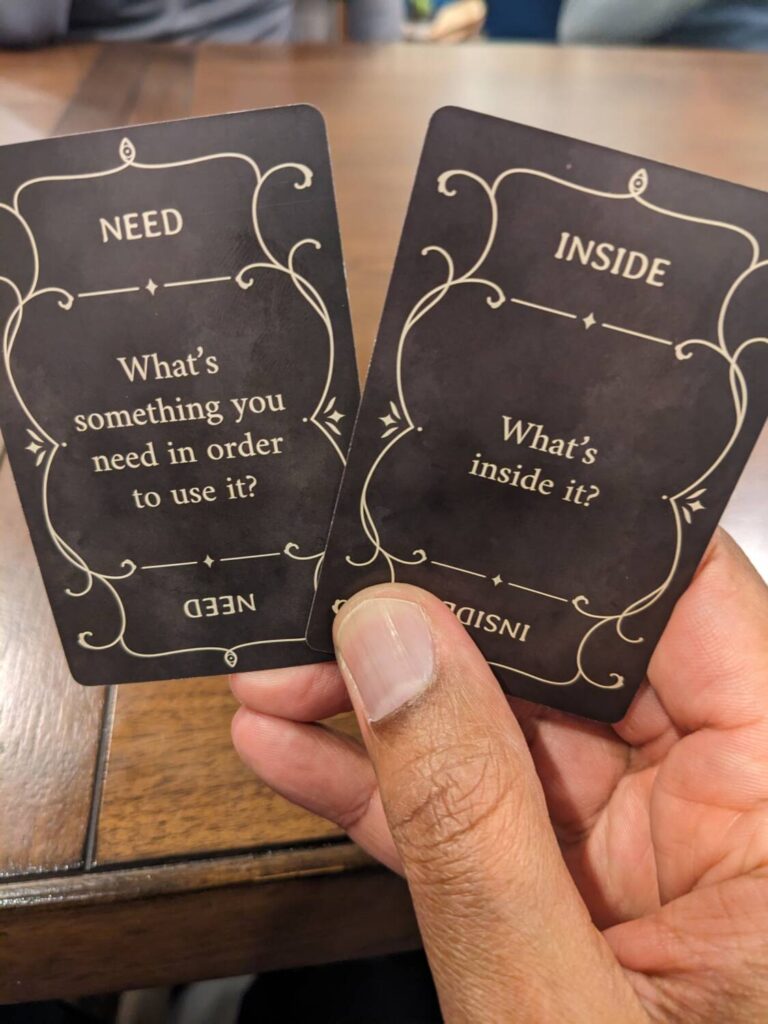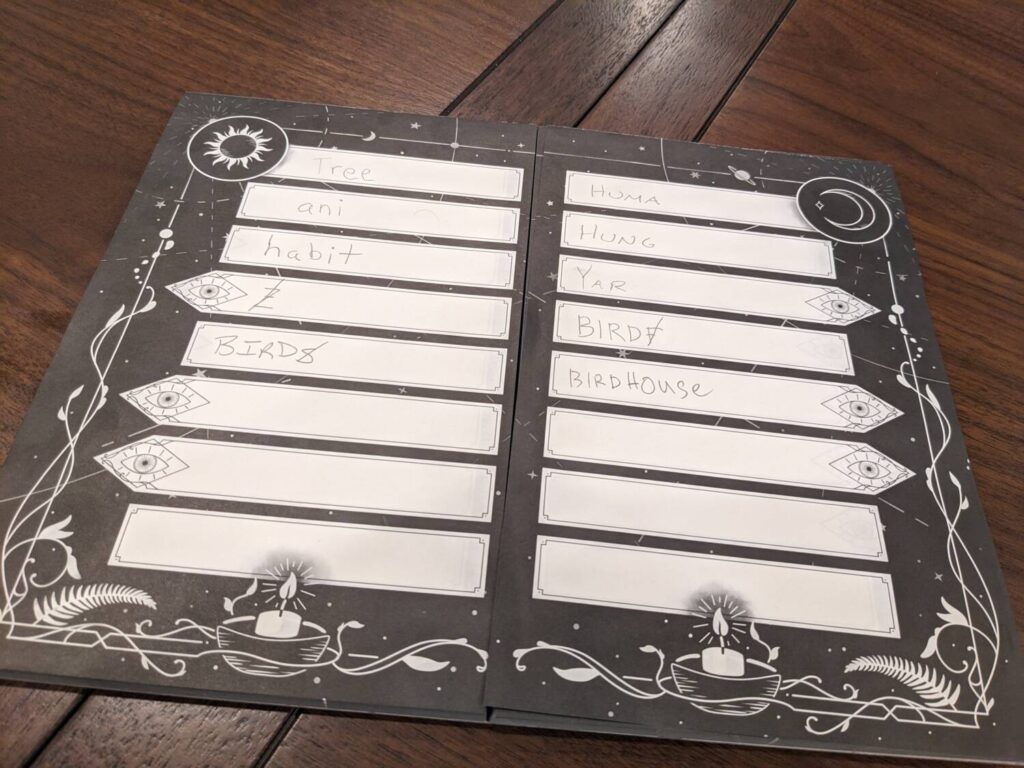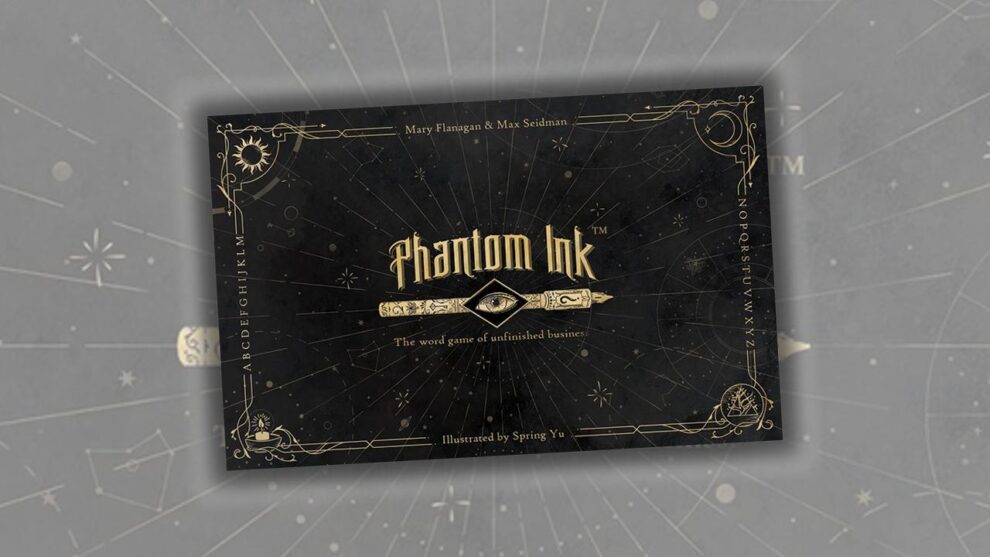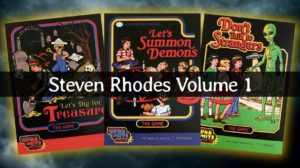Disclosure: Meeple Mountain received a free copy of this product in exchange for an honest, unbiased review. This review is not intended to be an endorsement.
Phantom Ink (2022, designed by Mary Flanagan and Max Seidman at Resonym) has been on my table sporadically over the last six months. During that time, I have hosted a decent number of game nights, get-togethers, and birthday parties. Despite all manner of other party games coming out—including Codenames, Wavelength, Just One, Slingz, Caution Signs, MonsDRAWsity, This Game is KILLER, Sushi Go! Party, and almost any other popular party game in existence—Phantom Ink was strangely hard to get to the table.
After my fourth play of Phantom Ink, I think I know the main reason why this game doesn’t appear as often when I get a large group together to play games.
“Phantom Ink is the first party game I would call a ‘silent party game’,” said my buddy Wil. “I really like it, but I wish we could do more talking.”
At press time, Phantom Ink was one of the top 50 games on BGG’s Party Game category sheet, and for good reason. The game uses a dramatic clue-reveal step each turn to help a team deduce where a team’s codemaster is trying to lead a group. (Phantom Ink has a seance/medium/spirit theme, as spirits try to help a team of mediums come up with a keyword before an opposing team tries to guess the same word.)
In perfect conditions, Phantom Ink was a hit with certain audiences. My findings? I don’t have enough of those “certain audiences” in my playgroups, because they would rather yell and scream than quietly deduce the solution in a mystery-themed game.

10-15 Minutes
Let’s talk about what made Phantom Ink really sing—those perfect conditions that I referenced above. First, let’s cover the very brief series of rules.
Two teams (the Sun team and the Moon team, each with at least two players per team) are working against each other as a set of mediums trying to deduce a single-word object clue. Each team has one spirit and at least one medium. To begin the game, the two opposing spirits draw a card, decide which of the six words on that card will be the shared clue for the current game, then begin play.
For the sake of this discussion, let’s pretend the selected object is “sandwich.”
Mediums have a hand of seven question cards, with any two given to a spirit for the current turn. Let’s say it is Team Sun’s turn. Sun’s mediums give their spirit two question cards: “What is your favorite of this object?” and “What happens to this object when it gets wet?” The spirit has to select one of the two question cards, so the Sun medium selects “What is your favorite?” They hand that card back to the team of mediums; they know what question the spirit is going to answer, but the other team’s mediums do not.
On the first line of the seven-lines-per-team answer sheet, the spirit has to slowly write one letter from the answer they are going to use for this round’s question. The spirit’s favorite kind of sandwich is an Italian hoagie, so the first letter they write is “I.” The Team Sun mediums have no idea what is going on yet, so the spirit slowly gets through T, A, and L before they realize what the answer might be. The Sun’s mediums collectively say “Silencio”, meaning to stop writing.
The Sun team has a little something, while the mediums for team Moon have a little something too. Turns alternate like this while teams try to give clues that keep their own team on the scent while hopefully throwing the other team off it. Occasionally, players get a one-letter addition to an existing clue from either team, in the hopes that they can clarify the direction teams are going.
Once a team of mediums wants to solve the puzzle, one medium has to slowly write the answer on the sheet. Letter by letter, the spirit for that team knocks once on the table if the medium gets a letter correct. (In each of my games, watching a medium get a clue wrong has been an exciting, often dramatic moment, usually tilting victory towards the other team.)
In perfect games, there has been drama, and at least one wrong answer. It was always a four-person game; none of my larger player count games worked as well. Those four-player games always took 10-15 minutes, and were over by the fourth line of the answer sheet. Everyone had good clue cards to choose from, and the medium/spirit relationship was fun to watch develop as the winning team used the right cards to get the right kinds of answers.
Two of my four plays were really cool in that way. At a recent birthday party, I left Phantom Ink on a table for two couples to try, two couples who didn’t know each other before the start of their first game. In a moment that I’m still shocked to recount here, these two couples played Phantom Ink FOUR TIMES in the span of just under an hour and came away from the experience by ordering their own copies of the game. (One of these couples bought the game online, on the spot. It’s always satisfying to push a new game in front of people and see them put their money behind their appreciation for the experience!!)
That experience at the birthday party also helped crystallize my thoughts on the game, and I wasn’t even at the table with those players. Phantom Ink is really good at four players when the conditions work out and players know their teammates at least a little. It’s also a great way for less talkative people—those who don’t love something like, say, Ready Set Bet when it comes to a party game—to flex the brain a bit and use their powers of deduction to play a team game.
My other plays of Phantom Ink? While not disastrous, they definitely helped bring the overall review score down a tad. That was due to a mix of my playgroups and the game’s playtime when conditions are less than ideal.

20 Minutes? Oh No
When Phantom Ink runs for even 20 minutes—not long by anyone’s standards, especially for a person who was cool playing a single game for an entire day—the juice almost immediately becomes “not worth the squeeze.”
Two of my Phantom Ink plays lasted about 30 minutes. By the fifth clue of the game, everyone was looking around, wondering what was taking so long. The team of mediums has to play a somewhat long waiting game, either for the other team to take their turn or to watch the spirit wiggle and waddle, trying to come up with a good answer to a question card.
When clues are off-track, it can be a frustrating experience for the mediums. In general, I found that I enjoyed Phantom Ink significantly more as the cluemaster (spirit) versus the clue receiver (medium). This isn’t a surprise. Lots of deduction games are more interesting for me as the codemaker, the guy behind the screen, from the classic Mastermind to more recent games like AI Space Puzzle.
But the player count was the big surprise, and the reason why I think Phantom Ink will come out most when we host another couple for dinner, versus a larger party environment. At even six players, Phantom Ink is a little bulky. That’s because it is so hard to talk to a partner about a clue that a spirit just dropped in a quiet room with other players. You also have more moments of second guessing your partner…and as one player joked in a recent four-player game, “I prefer to blame myself for getting the answers wrong, not a partner!”
My favorite part of my six-player games came whenever one of the two mediums knew what the spirit was going for, but the other player did not. “Silencio!” one person would yell. But then the other player didn’t know where the spirit was going, so they would huddle in a corner or whisper in their teammate’s ear. In one of my games, my teammate was WRONG about the clue, which threw our whole game off—a possibility with a multiplayer team of mediums in Phantom Ink, and that happened more than once.
More players also meant more game time, and again, 10-15 minutes is the sweet spot for this game.
All this means is that Phantom Ink will stay in the collection alongside Decrypto as a game I would love to break out for a four-player game night with friends, family, or ideally another couple after the kids go to bed. There are dozens of question cards and hundreds of final answer objects in the base game, so that’s all I really need. And for a player who wants more, Phantom Ink already has an expansion set to hit the market this year, the “expandalone” game Phantom Ink: Arcana.
If you like your party games thinky, give Phantom Ink a look!












Add Comment